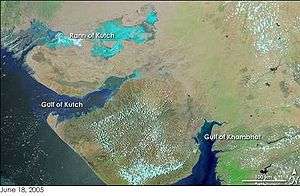Gulf of Khambhat
The Gulf of Khambhat, also known as the Gulf of Cambay, is a bay on the Arabian Sea coast of India, bordering the state of Gujarat.[1] The Gulf of Khambhat is about 200 km (120 mi) long, about 20 km (12 mi) wide in the north and up to 70 km (43 mi) wide in the south. Major rivers draining Gujarat are the Narmada, Tapti, Mahi and Sabarmati that form estuaries in the gulf.[2]

_1896.jpg)
_1896.jpg)
It divides the Kathiawar Peninsula from the south-eastern part of Gujarat.[3][4][5]
There are plans to construct a 30-kilometre (19 mi) dam, Kalpasar Project, across the gulf.[6]
Wildlife
To the west of the Gulf, Asiatic lions inhabit the Gir Forest National Park and its surroundings, the region of Kathiawar or Saurashtra.[3][7] To the east of the Gulf, the Dangs' Forest and Shoolpaneshwar Wildlife Sanctuary, where Gujarat meets Maharashtra and Madhya Pradesh, used to host Bengal tigers.[8]
See also
References
- Chisholm, Hugh, ed. (1911). . Encyclopædia Britannica (11th ed.). Cambridge University Press.
- Saha, S., Banerjee, S., Burley, S.D., Ghosh, A. and Saraswati, P.K. (2010). The influence of flood basaltic source terrains on the efficiency of tectonic setting discrimination diagrams: an example from the Gulf of Khambhat, western India. Sedimentary Geology 228 (1): 1–13.
- Nowell, K.; Jackson, P. (1996). "Panthera Leo". Wild Cats: Status Survey and Conservation Action Plan (PDF). Gland, Switzerland: IUCN/SSC Cat Specialist Group. pp. 17–21. ISBN 2-8317-0045-0.
- Trivedi, P. and Soni, V. C. (2012). Significant bird records and local extinctions in Purna and Ratanmahal Wildlife Sanctuaries, Gujarat, India Archived 2017-08-10 at the Wayback Machine
- Jhala, Y. V., Qureshi, Q., Sinha, P. R. (Eds.) (2011). Status of tigers, co-predators and prey in India, 2010. National Tiger Conservation Authority, Government of India, New Delhi, and Wildlife Institute of India, Dehradun. TR 2011/003.
- "The Gulf of Khambhat Development Project". Gujarat. Retrieved 18 May 2013.
- "Asiatic Lion population up from 411 to 523 in five years". Desh Gujarat. 2015-05-10. Retrieved 2016-11-26.
- Karanth, K. U. (2003). "Tiger ecology and conservation in the Indian subcontinent". Journal of the Bombay Natural History Society. 100 (2–3): 169–189. Archived from the original on 2012-03-10.